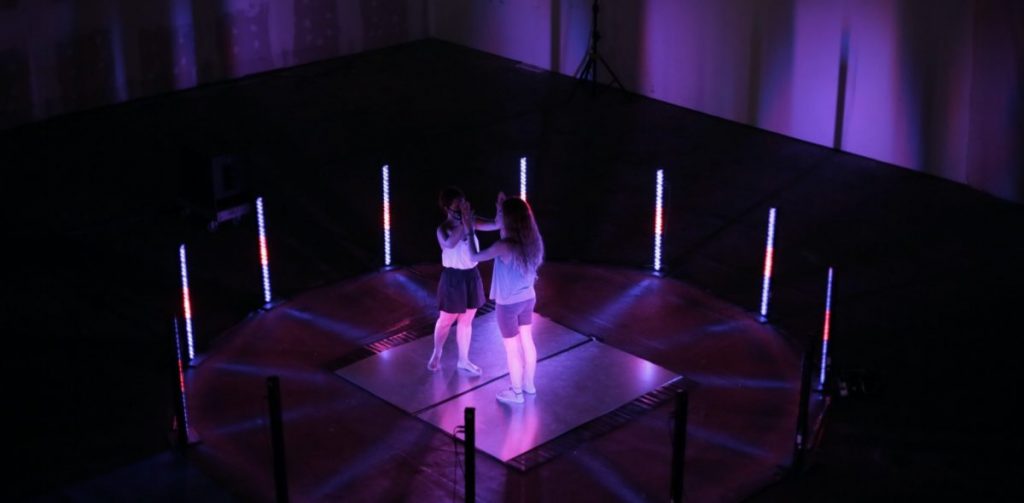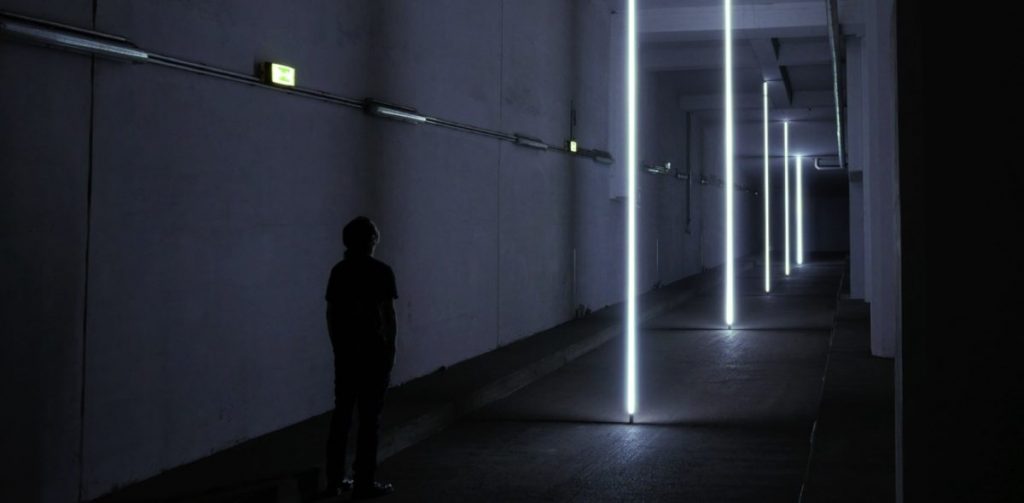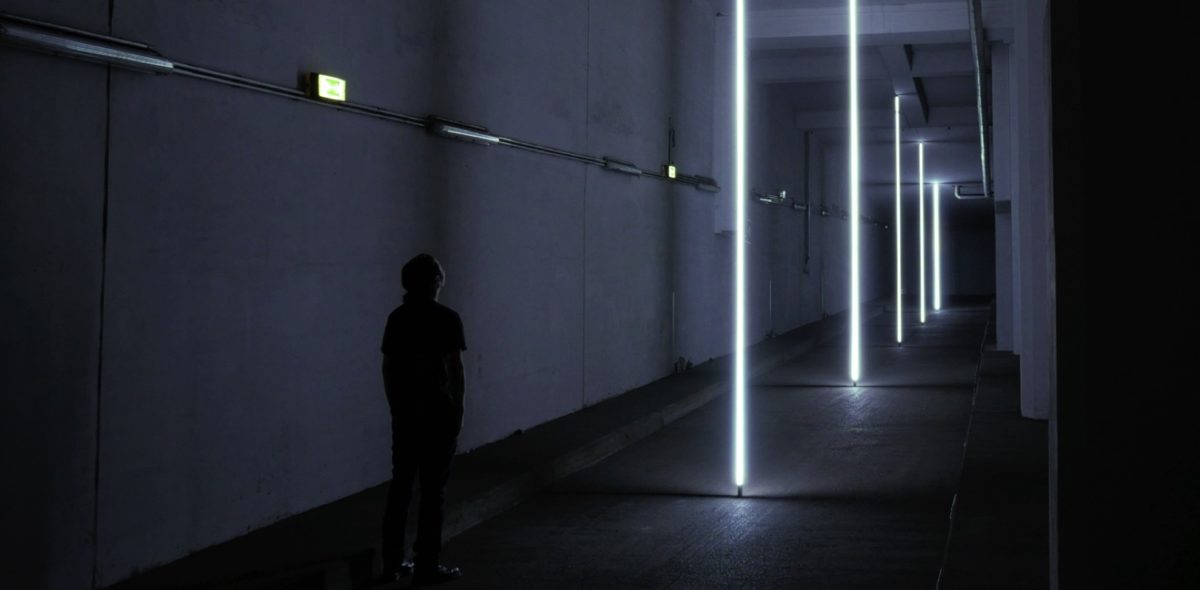Text by Nicholas Burman

In the heavily automated, networked “internet of things” future we’re unevenly rattling towards, there’ll be an increasing amount of discussion about interaction and interfaces. Actor–network theory has already been researching these sorts of questions for many decades, asking how individual actors and the networks they are part of build social forces and create events.
In its own small way, Eufònic Urbà’s 2021 programme brought these sorts of questions to the fore with a series of sound-light-technology-art installations that toyed with perceptions of agency and interactivity, cause and effect. Three of the installations are viewable throughout February 2021, while two more were only on show for a weekend.
Alfredo Costa-Monteiro’s En-lloc (Instead) was one of the two weekend-only installations and consisted of two screens placed on the floor of the wide stone staircase, showing an accordion being meddled with from two different angles while some pretty uncomfortable signals were amplified. Meanwhile, in the cavernous ground floor theatre, there was Cabosanroque’s Sous les violons, la plage!, a title inspired by the call of “Sous les pavés, la plage!” (under the cobblestones, the beach!) that rang out during France’s May 1968 protests.
The installation’s main relationship with those protests is that it seeks to create something in the act of taking some old apart. Visitors to the installation are encouraged to throw pieces of the rubble left on the ground at somewhat distant violins, viola and cello while the speakers play Haydn’s “String Quartet No. 66 in G major, Op. 77”.
Every time a piece of rubble successfully hits (and damages) one of the instruments the music alters in a dramatic way, either in timbre or tone, until it’s pretty much unrecognisable. This is all based on an algorithm’s randomised response to the instruments being hit. This was pure fun; because I’m essentially a caveman, throwing stuff at other stuff is very satisfying. I also appreciated the kid whose throw wasn’t too strong and so managed to make a dent in the monitor, much to the security’s annoyance.
Perhaps Santa Monica’s status as an ex-convent was in the back of my mind, but Tomonaga Tokuyama’s large scale installation in the second-floor room inspires imaginations of the religious and transcendental. Poètica de l’espai algorítmic (The Poetry of Algorithmic Space) is part of Tokuyama’s ongoing f( ) series of installations, which are attempting to distil humanity’s perception of the universe into multi-sensory, site-specific work. Nine light strips stretching from the floor to close to the ceiling are equally distributed as a grid through the room, flickering in an irregular manner while a low-level drone unnervingly hums away. Visitors are able to amble between the poles, noticing how the light changes one’s sense of space as they go.
It would have been meditative were it not for the fact that the sheer size of the piece and intensity of the light were somewhat unnerving. The piece’s religiosity isn’t pure projection on my part, I don’t think. While there is a complexity to Poètica de l’espai algorítmic in terms of its reliance upon software and programming, computer mechanics and new media technology, the result is strikingly simple. Like with many austere and oversized installations, I’m reminded of the Monolith in 2001: A Space Odyssey and the declaration, “let there be light.” It seems that no matter how complex or specific human methods of production become, a portion of the (arts) world is always attempting to return, through media, to unadulterated forms.
While Tokuyama is concerned with everything, Lina Bautista brings attendees’ attention to the micro. Her Kilobots are semi-autonomous cockroach-sized creatures made out of minuscule computer hardware and programmed to explore a small table amount of space continuously. From what I could tell, their legs are styluses and transmit a scraping, buzzing noise to the speakers in the room, making the little creatures even more bug-like than they first appear. Spend too long watching them and you might start thinking they have a personality.

Elsewhere, Love Synthetizer by Anaisa Franco and Lot Amorós is concerned with the scale of the human. Visitors turn into participants: people are required to take off their shoes and stand on two sides of a metal sheet, which sits in the middle of a circle of squat LED disco lighting. As the noise of those in the circle increases, so does the red in the lights, and when they touch, skin to skin, “across the divide” they become conductors, bringing spiralling, fantastical chimes to life.
The more people touch, and the more variety in their touching and movement, the greater the complexity and intensity of the music. Sous les violons, la plage! and Love Synthetizer are efficient attempts to bring some intimacy and visceral energy to the mix in order to counterbalance the rather impersonal attitude that art installations and art venues tend to facilitate. They’re pieces that require audiences to become involved in the work in order for the works to come into being.
In its minimalism and attempts at (literal) universalism, Tokuyama’s f( ) series is a work whose outcome rests a lot on the subjectivity of the spectator. Franco’s Synthetizer relies as much on subjectivities too, but plays on our expectations of permanence. We expect f( ) to be the same when we return to it – this is, perhaps, not much different than our expectations of the outside world more generally. We can’t expect the same thing with Synthetizer because each time it’s different, each instance of it relies on its audience and their propensity to perform, even if it’s just for themselves. Sometimes it doesn’t “work” at all, when people don’t know they have to take their shoes off for it to function, and stand around for a bit, looking perplexed and disappointed.
Agency is a theme that ties Synthetizer and Kilobots together. They both play with an understanding that agency is limited to the situation in which one acts. Kilobots suggests that machines have some autonomy. Its bug-machines scuttle about making noise without hindrance or help from a visible hand. Here, agency is more illusion than fact, placed upon the machine because of its animalistic qualities rather than due to any of its material or intrinsic characteristics.
Synthetizer plays with agency twofold: in terms of the human participants, who have to decide to (and then how they) interact with the piece, and also in terms of how the installation responds to this interaction. It would be impossible to disentangle the two, they rely on each other to come into being. Franco’s piece requires collaboration both between visitors and between her installation and visitors in order to be able to act at all.
At one point, a five- or six-year-old girl stood alone in the middle of Synthetizer’s circle, watched from a distance by her mother. Realising her voice could change the lights, she shouted “Hola!” Then, “Hola!” again. And then a couple of times more. Perhaps the red light was response enough, or perhaps she was hoping for some vocalised reply.
Maybe she realised that the lights and the noise weren’t really able to produce themselves, and required some other mysterious force in order to be. This is a person who’s grown up in a world that contains Siri and Alexa, of black boxes that speak back. Maybe she’s of a generation less concerned by what seems like a ghost in the machine, and more disturbed when such a ghost seems absent.
Postscript: On Santa Monica’s first floor, Eufònic’s visitors will come across a photo-reportage exhibition by Gervasio Sánchez which details the struggles of the indigenous and black populations of Guatemala and Honduras against international and national corruption. A lot of their struggles are born out of issues over resource extraction and the corporate stealing of communal land. Local minerals are mined and ecosystems are destroyed for the benefit of “progress” elsewhere.
It’s always worth remembering that the media that seems so sterile and glossy here in the West, such as the tech I’m writing this review on and that forms the backbone of Eufònic’s installations, is made possible, at least under the current economic system, because of exploitation and destruction in the Global South. When the machines do eventually speak to us, not on demand but from some inbuilt will, will they speak of where they’ve come from? Of how they’ve been built?






